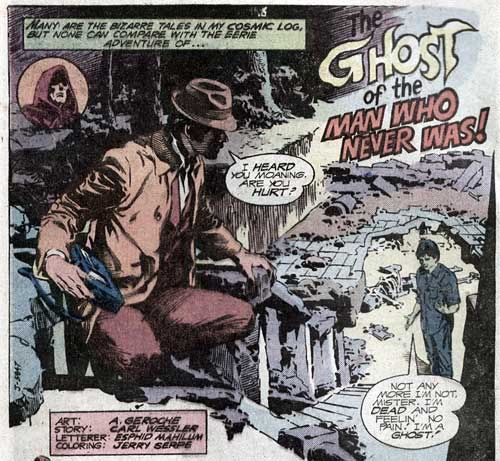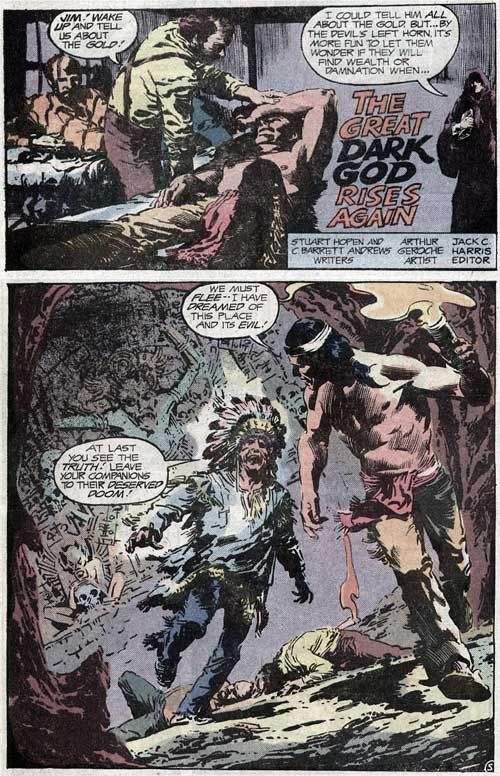
Art Geroche
Philippine Comic Art Portfolio
Art Geroche is one of those artists I haven't featured in this site until now. He's part of a newer generation of comics illustrators (with respect to Nestor Redondo's generation) who exhibit a style of art that have evolved out of the homegrown style so common during that time. I actually don't have any local komiks with his art on it, only a few DC published horror stories, and the art portfolio that Steve Gan published a while back.
I think his art is remarkble in its realism, a level of which is not too common in their generation of artists or even generations before.
In Comic Book Artist #4 David Roach writes of Art's art:
"Apparently something of a late bloomer in the Philippines, Geroche was too late for DC's horror boom, only managing six strips before the line went under. But what strips! Geroche's dark, vibrantly expressive work was a mix of Gene Colan, Doug Wildey, and the Spanish grand master, Jesus Blasco. That he should have done so little for the US is a real tragedy."

"The Ghost of the Man Who Never Was!"
Secrets of Haunted House Vol 6. #21
February 1980
DC Comics

"The Great dark God Rises Again"
Secrets of Haunted House Vol. 7 #38
July 1981
DC Comics
*******************************
I was very surprised and a little puzzled that Art Geroche's son would post on Dennis Villegas's blog and say hurtful and unfounded things about me and my contemporaries, contending that artists like me do comics for the money, and that I can't possibly REALLY love what I am doing because I'm off in America doing their American comics. He continues to note the merits of illustrators like Hal Santiago and other Liwayway magazine illustrators and suggest their 2005 and 2006 works and the works of other "classic" artists be featured in his blog.
I guess it's apprent that he had yet to visit this site before he found Dennis' site, because if he did, he would realize much of what he was thinking about me were simply downright wrong. Hal Santiago, Jun Lofamia, Rod Lofamia, Abe Ocampo, Rico Rival and many other current Liwayway artists and other "classic" artists are regularly featured on this site for several years, and in fact, there is a whole online museum I put together devoted to celebrating their contribution to Philippine comics.
Why did I decline inking Ultimate Hulk and Wolverine for Marvel inspite of it being offered to me, and decided instead to concentrate on doing my own work for publication right here in the Philippines, if I was doing it for the money?
Why do I continually do comics locally for little or no pay at all if I didn't have any great love for comics?
I'm just a little frustrated that some people would go off saying hurtful things about people without checking out if what they are saying is true or not. I hope that when one of these days he does a search on the work of his father, it would lead him here and see for himself.
I realize that he based his opinions on comments made by writers for the Comic Book Artist Magazine #4, the magazine I had been mentioning here quite a bit because it was almost entirely devoted to Filipino comic book artists.
There have been some points about some articles written there that I objected to in my mind, but perhaps blinded by sheer joy in seeing an American publication putting the spotlight on fellow Filipinos and their work, I was probably too excited to say anything about it.
But now, seeing that these same points are now being taken out of the whole and used against me and my contemporaries, I feel that I have to say some things in our defense.
This is a somewhat edited copy of a letter I sent to the magazine's editor.
*************************
Hello Jon!
I finally managed to find time to settle down and write a reaction to the various articles written in the magazine. I remain amazingly pleased and amazed that it took Americans to put much value in the work of Filipino artists.
I do have to provide a different point of view with regards to David Roach's opinion about the current generation of artists:
"With a very few exceptions, the Filipino invasion of comics is now over, and their '70's heyday is either ignored by collectors or misunderstood. In recent years, a third wave of creators has entered the US, but I suspect that few readers are aware that the likes of Whilce Portacio, Leinil Francis Yu, Jay Anacleto, Lan Medina and Gerry Alanguilan are indeed Filipino. Their art reflects the US Comics Mainstream of the past decade rather than their own visual heritage, and they clearly work in a different artistic tradition, with little in common with their predecessors. This is probably good for them commercially, but it means that the traditional Filipino style is all but dead. So for the purposes of this article I shall deal with only with the first two waves of Filipino artists."
David Roach goes on to list all Filipinos who have worked in US comics and describes their work.
I wholeheartedly agree that the traditional Filipino style is all but dead. It is a fact that I personally grieve over, and I try my best not to let at least the memory of it die out by putting up my online museum of Philippine comics art. I welcome this issue of your magazine wholeheartedly because it gives due importance to a movement of art that is historically significant in comics.
But I do think it a bit unfair that any other artist who does not fit the writer's idea of "traditional" Filipino style to be unworthy of further mention in his article, dismissing a new movement in Philippine comics art which may well be considered by future writers ignored and misunderstood by writers of today.
And I think misunderstood may well be the right term for it.
I have nothing but great respect for the work and accomplishments of our old artists, but to say that the "Filipino comics invasion is now over" would hardly be factually correct.
In fact, this new generation of artists have managed to penetrate markets that the previous ones have only rarely managed to. While the earlier generations may well have been unfairly pigeonholed only into mystery, horror, western, sci fi and war titles (but at times dominating them completely), this current generation of artists have managed to work on mainstream titles that have been rarely, and in most cases, have not been previously touched by Filipinos.
These are titles like X-men, Wolverine, Superman, Batman, Hulk, Fantastic Four, etc. Earlier generations may have worked on them as inkers, but hardly never as pencillers as the current generation are for the most part doing.
They are working as pencillers, aside from those titles already mentioned, on Spawn, Fables, Battle of the Planets, Tomb Raider, House of M, Planet Hulk, Elektra, Ultimate Hulk and Wolverine and so many more, titles that are at the upper end of the commercial comics market.
The invasion is much more penetrating and much more invasive now than it ever was before.
To require these artists to conform to a "traditional style" before their contributions can be considered valid and worthy (at least as far as this article is concerned) is grossly unfair. It's true that many of them reflect the comics mainstream of the past decade, but please don't forget that Whilce Portacio, a Filipino, was part of the movement that created the predominant style of the 90's comics mainstream in the first place. Such a contribution cannot be and should not easily be dismissed.
Additionally, to require Filipino artists today to carry the "traditional style" before their contributions be considered valid and worthy is tantamount to restricting creativity. Artists should be allowed to grow, to find their own voice, to carve their own individuality and be unique, not just be another player in a larger tradition of a "style".
If one looks closely at the art of Whilce Portacio, one will realize that, even though it owes very little to previous Filipino artists, his style owes very little to any American, European and Asian artist either. It's totally unique and there is nothing else in the comics industry like it.
If one looks very closely on the art of Lan Medina and Roy Allan Martinez, one will realize that they owe more to traditional Filipino art than what is easily apparent, but they have managed to gather up much of their own creativity to create something unique.
Jay Anacleto... well, there's simply no one else like him.
Leinil Francis Yu, influenced as he is by many western artists, he is still able to create work that is uniquely his own. He is an artist just like any American or European artist: they are influenced themselves by what they like. And they all create something that can only be identified with them.
There is hardly anything in common between their styles to identify them as belonging to one movement of style, but why is that considered a bad thing?
Variety is a triumph of creativity. Nothing becomes predictable, and the potential for something new and fresh never ends.
I believe the artists I listed above are doing really good, visually remarkable work. The quality of their art can stand toe to toe, and even far surpass any current Western and Asian comics artist. To dismiss their work simply because their art owes little to early generations of Filipino artists simply isn't right.
This message is a plea for a second look, spoken by an artist who is part of a generation of artists that is in danger of being dismissed because I believe that we are misunderstood and overlooked. I am by no means saying that we are better than our previous generation of Filipino artists. Far from it. Indeed, I think many of them are far superior to us artistically in many ways. But I believe we are nevertheless doing work that has much worth.
Gerry Alanguilan
*******************
